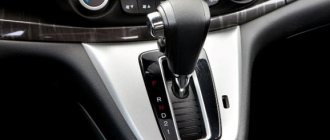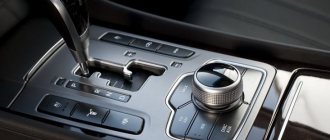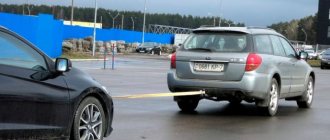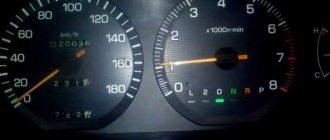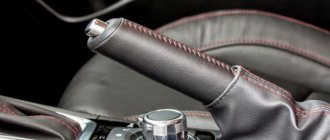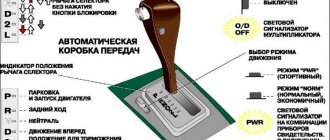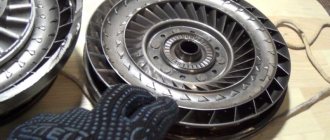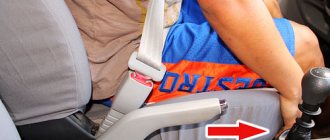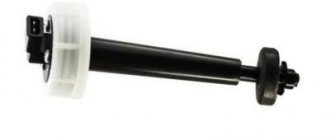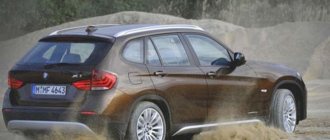The first generation automatic transmissions, which did not yet have manual speed control, used a special design with reduction gears. Many drivers simply do not understand why downshifts are needed on an automatic transmission and how to use such a gearbox correctly. Let's take a closer look at what downshifts are used for on an automatic transmission.
Band D: Drive mode
The car is most often in the Drive position. Used when moving under standard conditions. Including the transition from first to fourth gear occurs automatically as needed.
To enter this mode, you need to slow down a little and move the lever to position D. Then the transmission turns on within one second. Afterwards you can start moving.
The advantage of the mode is that the box performs actions automatically. The driver just needs to regulate the speed of the car by pressing the gas pedal. Only when the lever is in D can the car reach maximum speed.
Techniques for driving a car with an automatic transmission
Having understood how gears are changed on an automatic transmission, and also having examined the main operating modes of an automatic transmission, you can move on to how to drive an automatic transmission.
Let's start with the basics. It is important to understand that the automatic transmission is “afraid” of constant sharp acceleration from a standstill, as well as wheel slipping in mud, snow or ice. Such conditions lead to the automatic transmission overheating.
For example, if the car is slipping, and no mode allows you to leave, it is better to seek outside help and simply push the car or tow it in N mode.
Let's get back to driving an automatic and how to drive a car with an automatic transmission. Driving a car with an automatic transmission comes down to the following:
- You need to start using the automatic transmission with the brake pedal pressed.
- by pressing the brake, to start moving, move the selector from P or N to the desired mode (R, D, 3, 2, L);
- If the parking brake was previously applied, the handbrake must be “lowered”.
- by removing the car from the handbrake and releasing the brake pedal, the car will slowly and smoothly begin to move (in some cases, for example, if the car is standing on an incline, there will be no rollback in mode D, but there will be no obvious forward movement);
- To accelerate, you need to press the gas pedal (accelerator). In D mode, the automatic transmission will automatically upshift when accelerating and downshift when decelerating. To reduce speed slightly without using the brakes, simply release the gas completely.
- To achieve effective deceleration/full stop, you need to apply the brake. To further accelerate, just release the brake again and press the gas.
- There is no need to switch the selector from mode D to mode P or N during short stops (these modes are activated only during long periods of inactivity with the internal combustion engine running for 10-15 minutes or more).
- Taking into account the presence of different operating modes of the automatic transmission, the driver should select the one that is best suited for specific operating conditions.
Please note that it is prohibited to move the selector to positions P and R until the car has come to a complete stop or while moving. Ignoring this statement will lead to serious damage to the automatic transmission.
It is also strongly recommended not to turn on N while driving, as this may cause a skid on a snowy road or on ice. It is not prohibited to switch the box to other modes while driving.
It should also be taken into account that if there is a need for the car to remain idle for a long time with the engine running (traffic jam, etc.), while high outside air temperatures are noted, then the selector must be switched from mode D to mode N to avoid overheating of the automatic transmission.
How to change gears on an automatic transmission
Let's start with the fact that using the automatic transmission is quite simple and convenient. When driving, such a gearbox itself selects the required gear ratio, taking into account the engine load, vehicle speed, gas pedal position, etc.
As for the driver, the main task is to select the desired mode using the selector inside the car. However, in practice, not all drivers know how automatic transmission modes are switched to control the box and what they mean.
So, let's consider a traditional hydromechanical automatic transmission (automatic transmission with gas turbine engine). Automatic transmission control assumes the following modes:
- P - parking mode, parking. You can switch the automatic transmission selector to this mode after the car has come to a complete stop if no further driving is planned (the car is parked). You can also start the internal combustion engine in this mode (for example, to warm up).
The only thing to avoid breakdowns is if the car is parked on an uneven surface (there is a significant slope), you first need to tighten the parking brake (handbrake), and only then switch the selector to the “parking” mode.
Without going into details, when you put it in “P” mode, a lock is activated in the box, that is, the car will not roll forward or backward. However, if there is a slope and the parking brake is not applied, the entire load falls on the rather fragile locking mechanism.
By the way, when parking on a level surface, there is no urgent need to tighten the parking brake. This allows you not to use the handbrake in winter, which, in turn, eliminates freezing of the rear brake pads, jamming of the brake cylinders, etc. (especially in the case of rear drum brakes).
- D - forward movement, gears change automatically. This mode is standard for automatic transmission.
When driving in “drive” mode, in case of a short stop (for example, at a traffic light), the driver only needs to hold the car by pressing the brake pedal. In this case, there is no need to switch the selector to P mode. Also, when you release the brake pedal, a car with an automatic transmission will not roll back if the road has a slope.
- R – reverse, reverse. Enabling this mode means that a car with an automatic transmission will only move backward (reverse gear is engaged).
Please note that R mode can only be activated when the car is completely stopped. Moreover, switching to this mode should only be done with the brake pedal depressed. This prevents the car from rolling forward or backward if the car is parked on uneven ground.
- N – neutral gear (neutral, neutral). This mode means that the gearbox and engine are open. This mode allows you to warm up the engine, tow a car with an automatic transmission without hanging the drive wheels, etc.
It must be taken into account that if the car is set to N mode, on a slope without the brake pedal pressed or the handbrake engaged, the car will roll down.
- Modes D3, D2, D1 (on different automatic transmissions they are designated L2, L or may simply be designated 3, 2, 1, etc.) are actually a lock for upshifts.
For example, D1 or L means that the car will only move in first gear, D2 means that the box will not shift above second gear, etc. The specified modes are necessary for severe operating conditions (for example, driving in a tight position, driving at low speed, driving on snow, ice, slippery surfaces).
In these modes, a more pronounced engine braking effect appears, which makes driving on mountain serpentines, roads with frequent descents and ascents, etc. easier.
- Additional automatic transmission modes from different manufacturers may be designated: S-sport mode, E - economical, W-winter, etc.
For example, in sport mode, the automatic transmission will “delay” the shift and shift to a higher gear at high engine speeds. This allows the car to dynamically accelerate from a standstill and overtake.
In economy mode, on the contrary, gear changes will occur earlier, the engine does not “spin up”, and the mode itself is suitable for quiet driving.
In W (winter) or S (snow) mode, the box distributes torque so that the drive wheels do not slip. To put it simply, the car starts off not from first, but immediately from second gear.
The winter mode of the “automatic” assumes that the gears are switched smoothly (at lower engine speeds). This is necessary in order to achieve smooth shifting and eliminate the possibility of skidding. We would like to add that this mode is strongly not recommended to be used when the temperature outside is above zero.
We also note that some automatic transmissions have an “overdrive” mode, which disables the transition to the highest gears. For example, a 4-speed automatic transmission will not shift to fourth gear. This mode is well suited for driving within the city, where speeds are low and traffic involves constant acceleration and stopping.
- Let’s add that the automatic transmission also has a so-called “kick-down” mode (literally, impact or drop down). This mode involves a sharp downshift for intense acceleration if the driver presses the gas pedal hard.
Activation of “kick-down” is usually done by pressing the accelerator pedal ¾ of the way, after which the automatic transmission switches to a lower gear, engine speed increases, and the car actively accelerates. This mode is indispensable when overtaking, sudden lane changes in traffic, etc.
- It is also worth highlighting the possibility of manual gear shifting on many automatic transmissions. This function, well known as Tiptronic, allows the driver to upshift and downshift independently.
As a rule, this function cannot be called a completely “manual” gear shift, since the gearbox operates in semi-automatic mode, simulating manual control.
Special automatic transmission operating modes
Before you get behind the wheel of a new car, it is better to learn more about the driving features. Especially if it is a car with an automatic transmission.
Simple or normal mode - standard Drive. By turning on D, the machine will do everything for you. In combination with Drive, or separately, you can use special driving modes:
- 2 or 2L;
- 3 or D3;
- 4 or D4.
2 or 2L
The letter L is from the English word low - slowly. The two means that the car will move forward with such a shift, using second gear. In other words, 2, 2L or L means driving slowly in no higher than 2nd gear.
Using slow L mode is essentially the same as 1st gear in a manual transmission. Well suited for slow starts and driving on slopes, slippery and loose surfaces. While driving, you can effectively brake with the gearbox on a descent or when obstacles arise along the way.
Attention! On some all-wheel drive vehicles, L mode locks the differential. What is recommended to be done only when the car is stationary.
Starting in second gear allows you to reduce torque on the wheels and minimize the possibility of slipping. This is an off-road driving mode, but it is suitable for leisurely driving through city traffic jams and provides good engine braking.
There is no need to remember about saving in mode 2 or 2L. The engine consumes fuel in maximum quantities.
3 or D3
D, of course, drive and movement forward. The three limits shifting to no higher than 3rd gear. The car starts and moves in 2 - 3 - 2 gears. Shifting from 2 to 3 is done at a slightly higher rpm than usual. When the speed decreases, the transmission switches to 2 at lower than usual speeds.
In fact, this is the ideal mode for winter driving on slippery roads. Suitable for comfortable movement around the city, but with slow acceleration. However, engine braking is not very effective.
Fuel consumption, of course, is more pleasant compared to the 2L, but still leaves much to be desired.
4 or D4
Drive using 4 modes ensures normal start and driving in the ranges from 1 to 4 gears. Switching occurs without delay. Suitable for city driving, without heavy traffic jams, and for leisurely country driving.
The car consumes fuel moderately, as in normal city mode.
